- Region
- Águilas
- Alhama de Murcia
- Jumilla
- Lorca
- Los Alcázares
- Mazarrón
- San Javier
-
ALL AREAS & TOWNS
- AREAS
- SOUTH WEST
- MAR MENOR
- MURCIA CITY & CENTRAL
- NORTH & NORTH WEST
- TOWNS
- Abanilla
- Abarán
- Aguilas
- Alamillo
- Alcantarilla
- Aledo
- Alhama de Murcia
- Archena
- Balsicas
- Blanca
- Bolnuevo
- Bullas
- Cañadas del Romero
- Cabo de Palos
- Calasparra
- Camping Bolnuevo
- Campo De Ricote
- Camposol
- Canada De La Lena
- Caravaca de la Cruz
- Cartagena
- Cehegin
- Ceuti
- Cieza
- Condado de Alhama
- Corvera
- Costa Cálida
- Cuevas De Almanzora
- Cuevas de Reyllo
- El Carmoli
- El Mojon
- El Molino (Puerto Lumbreras)
- El Pareton / Cantareros
- El Raso
- El Valle Golf Resort
- Fortuna
- Fuente Alamo
- Hacienda del Alamo Golf Resort
- Hacienda Riquelme Golf Resort
- Isla Plana
- Islas Menores & Mar de Cristal
- Jumilla
- La Azohia
- La Charca
- La Manga Club
- La Manga del Mar Menor
- La Pinilla
- La Puebla
- La Torre
- La Torre Golf Resort
- La Unión
- Las Palas
- Las Ramblas
- Las Ramblas Golf
- Las Torres de Cotillas
- Leiva
- Librilla
- Lo Pagan
- Lo Santiago
- Lorca
- Lorquí
- Los Alcázares
- Los Balcones
- Los Belones
- Los Canovas
- Los Nietos
- Los Perez (Tallante)
- Los Urrutias
- Los Ventorrillos
- Mar De Cristal
- Mar Menor
- Mar Menor Golf Resort
- Mazarrón
- Mazarrón Country Club
- Molina de Segura
- Moratalla
- Mula
- Murcia City
- Murcia Property
- Pareton
- Peraleja Golf Resort
- Perin
- Pilar de la Horadada
- Pinar de Campoverde
- Pinoso
- Playa Honda
- Playa Honda / Playa Paraíso
- Pliego
- Portmán
- Pozo Estrecho
- Puerto de Mazarrón
- Puerto Lumbreras
- Puntas De Calnegre
- Region of Murcia
- Ricote
- Roda Golf Resort
- Roldan
- Roldan and Lo Ferro
- San Javier
- San Pedro del Pinatar
- Santiago de la Ribera
- Sierra Espuña
- Sucina
- Tallante
- Terrazas de la Torre Golf Resort
- Torre Pacheco
- Totana
- What's On Weekly Bulletin
- Yecla


- EDITIONS:
 Spanish News Today
Spanish News Today
 Alicante Today
Alicante Today
 Andalucia Today
Andalucia Today
Semana Santa in the Region of Murcia, the essentials
Semana Santa in the Region of Murcia, Basic information
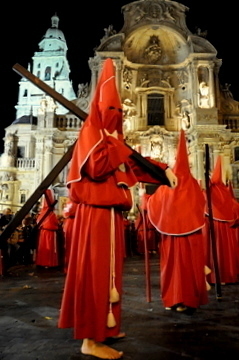
The main body of activities begin on Viernes Dolores, followed by Palm Sunday, then there are processions throughout the week culminating in the procession of resurrection on the Sunday morning, our Easter Sunday.
The Semana Santa ( Holy Week) activities, parades and religious programmes are all organised by the Cofradías, also known as Hermandades or Brotherhoods and many were established hundreds of years ago, although there are new brotherhoods being created every year. During the troubled times of the Spanish Civil War, and the turbulent times of change which beset Spain following the war, many Cofradias fell 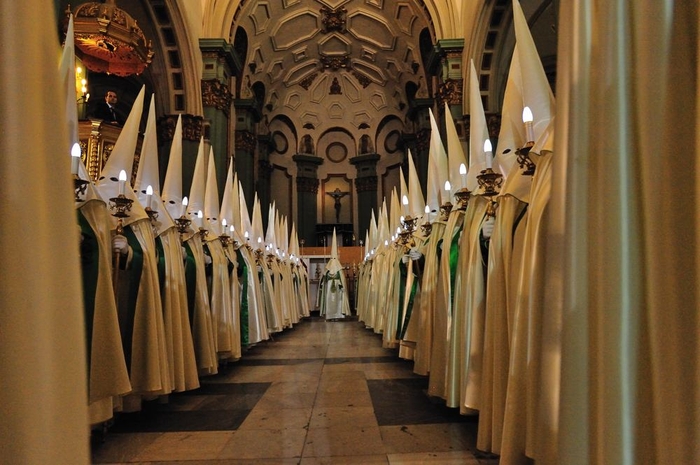 apart or were disbanded, and religious traditions discontinued, but Semana Santa and its rites have enjoyed a revival in the last few years, some Cofradias have reformed or new ones started up as Spain embraces its inherited traditions. The larger Cofradias are subdivided into smaller "subdivisions", necessary as in some of the larger parades such as that of the Coloraos, the reds, in Murcia, 4000 penitents will walk together in the procession.
apart or were disbanded, and religious traditions discontinued, but Semana Santa and its rites have enjoyed a revival in the last few years, some Cofradias have reformed or new ones started up as Spain embraces its inherited traditions. The larger Cofradias are subdivided into smaller "subdivisions", necessary as in some of the larger parades such as that of the Coloraos, the reds, in Murcia, 4000 penitents will walk together in the procession.
Each Cofradia has its headquarters where the sculptured pasos, statues which form the focal point of their processions are stored, often a church, and each Cofradia has its own pasos, embroideries and robes, all financed by the members of the Cofradía.
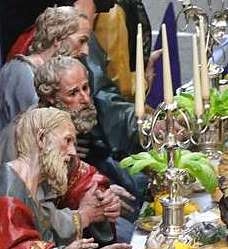 There are three types of pasos, an allegorical scene or a scene of the passion of Christ, known as a misterio, then the images of Christ, and thirdly the image of the suffering Virgin Mary, known as a dolorosa.
There are three types of pasos, an allegorical scene or a scene of the passion of Christ, known as a misterio, then the images of Christ, and thirdly the image of the suffering Virgin Mary, known as a dolorosa.
Some of these pasos are priceless, carved by the great masters of Murcia: youll see the name Salzillo cropping up from time to time, Murcias´s great Master of the Baroque. If you want to see the most stunning of all, go to Murcia on the "day of the Salzillos" and if you can´t do that, at least go to the Salzillo Museum and see the great pasos which are on display all year around, albeit without their floral decorations.
The pasos are transported on enormous structures known as tronos, thrones, which bear the pasos and their accompanying decoration. These are usually floral, intertwined with sumptuous fabrics, fruits and candles and are not only vast, but unwieldy and heavy.
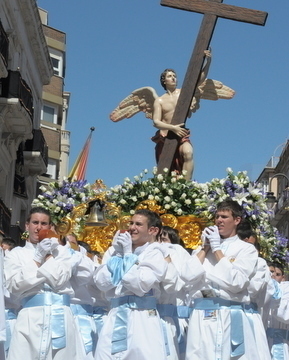
Each town and city has its own peculiar character and each procession has a unique atmosphere of its own due to the manner in which they take place. In Cartagena the narrowness of the streets and size of the tronos is not only the reason for the rigid military discipline of the silent lines of penitents: there is also fierce rivalry between the Cofradias, as navigating the tight corners with only cm to spare is incredibly difficult, whilst in Lorca the rivalry is on display for all to see - will the whites or the blues sell the most tickets and outdo each other in the magnificence of their displays and the breathtaking daring of their horsemen.
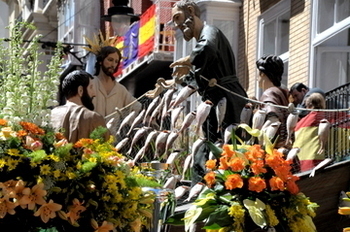
The name of those bearing the tronos varies from place to place, but you´ll see the names costaleros or portapasos also used, due to the little pad, the costal, which they wear on their shoulders to ease the burden of the tronos, which can easily weigh a ton. It has been estimated that each costalero bears 100kg, which can weigh very heavily when the parades last for several hours, as many do, although bearing this weight is a tremendous honour and its done with great pride.
The Nazarenos all wear distinctively coloured robes, and carry extravagantly embroidered standards bearing their insignia, which also appear on their robes. Some are full length, others knee length and are known by various names across Spain, San benito, zamarra or abito.
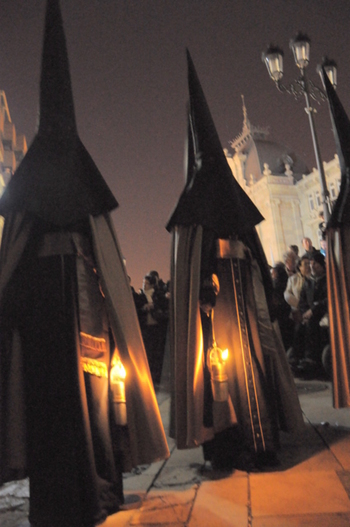
You will also see penitentes, who sometimes carry wooden crosses and have no point in their hats, some of whom walk barefoot. Participation in the parades is an act of penance, so the normal procedure is to walk in silence, faces covered, solemnity the order of the day, particularly on the Thursday evening when lights are extinguished and the penitents walk in absolute silence.
Again, each area has it´s variations - in Murcia capital the robes are short, knee length, with distinctive hand crocheted stockings, stuffed with food so that gifts can be handed to onlookers throughout the 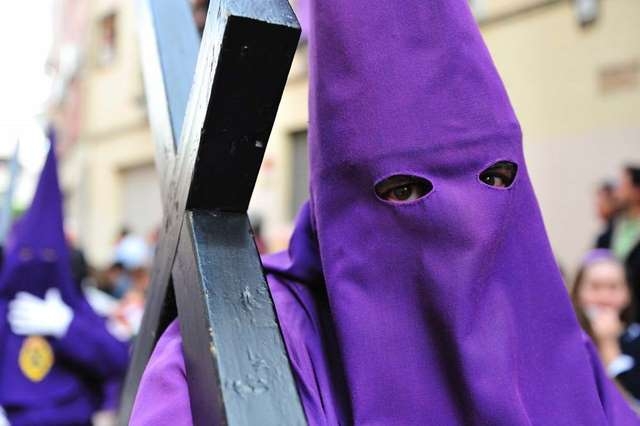 route, in Lorca the caps worn by the participants are unique and the embroideries astonishing, whilst in Jumilla the loose tunics are totally distinctive compared to those of, say, the sleek satins of Cartagena.
route, in Lorca the caps worn by the participants are unique and the embroideries astonishing, whilst in Jumilla the loose tunics are totally distinctive compared to those of, say, the sleek satins of Cartagena.
Each procession represents part of the week, so on Palm Sunday, known here as passion Sunday the mood is of celebration as Jesus enters Jerusalem on a donkey, by Wednesday the mood has turned to despair, by Thursday lights are extinguished as the Nazarenos march through darkened streets, remembering the betrayal and taking of Christ and on Friday, all are in mourning for the death of Jesus. Saturday is a day of reflection, of contemplatiion following the passion of the crucifixion, then on Sunday the mood changes to light as white flowers and shining white robes celebrate the resurrection.
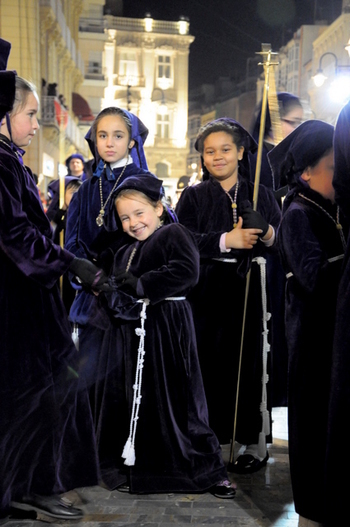
Auto Sacramental
Other names you will come across this week are Auto sacramental, which is equivalent to a passion play, many texts dating back to the 17th century and still widely performed in churches today.
There are choral performances all over the place, treat after treat as the churches and plazas are filled with beautiful choral music, and all the concerts are free.
Via Crucis
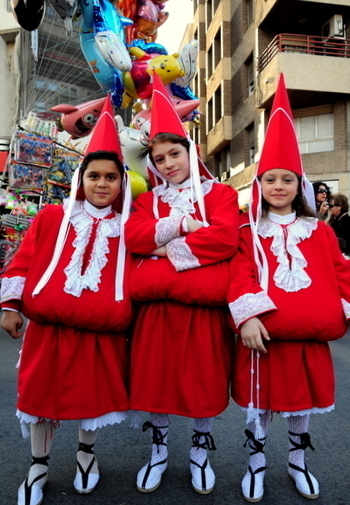
Jesus in the Garden of Gethsemane,
Jesus is betrayed by Judas and arrested
,Jesus is condemned
Jesus is denied by Peter,
Jesus is judged by Pilate,
Jesus is scourged and crowned with thorns,
Jesus takes up His cross,
Jesus is helped by Simon to carry His cross,
Jesus meets the women of Jerusalem,
Jesus is crucified,
Jesus promises His kingdom to the repentant thief,
Jesus entrusts Mary and John to each other,
Jesus dies on the cross,
Jesus is laid in the tomb.
There are 14 of them, and in every town and village you will find a route which marks these 14 points at which the Via Crucis stops. One which is of particular note is in Totana, where they have a beautiful sculptural Via Crucis, Click Via Crucis, Totana.
During lent the faithful walk the Via Crucis, with readings and prayers at each station. These Via Crucis are often at night or early in the morning.
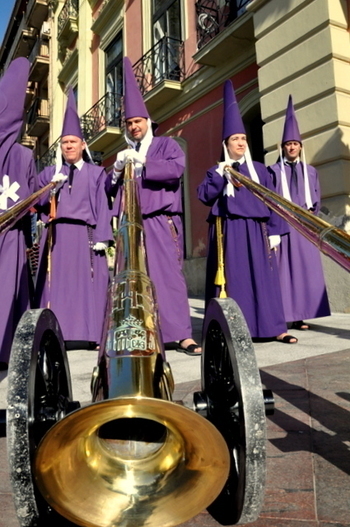
I still find a deep emotional pleasure in following the route of a Via Crucis and being part of the experience, and they´re all different.
Some of them leave at the crack of dawn- throughout lent they have been leaving Murcia Cathedral before daylight breaks, and youll see them celebrated in many forms throughout Murcia.
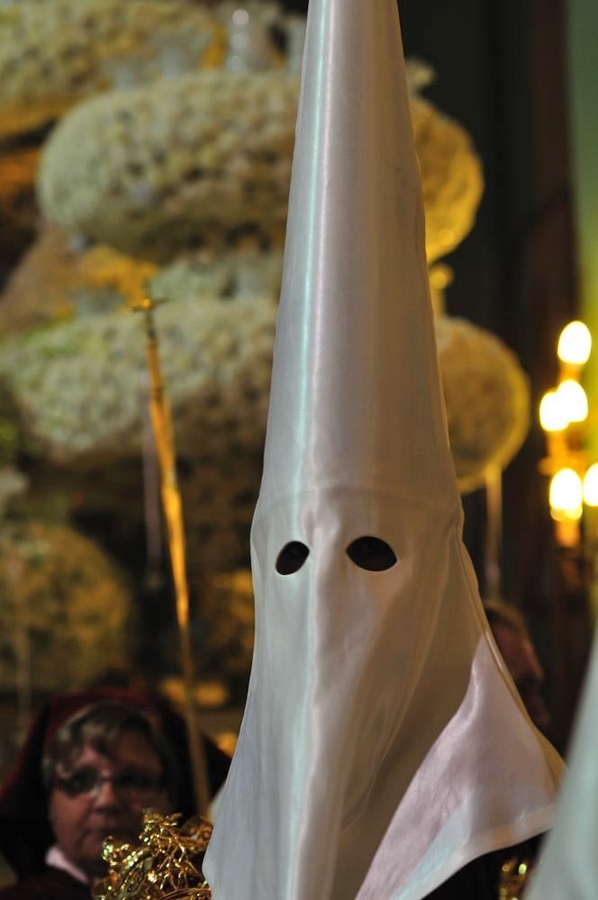 Each parade is different, each town and village is different. If youve been to Cartagena once, try a different night and if youve only ever been to Murcia, go to Alhama or Totana and feel the swish of satin as it brushes against your legs, smell the flowers, and crush against the narrow streets as the tronos squeeze past.
Each parade is different, each town and village is different. If youve been to Cartagena once, try a different night and if youve only ever been to Murcia, go to Alhama or Totana and feel the swish of satin as it brushes against your legs, smell the flowers, and crush against the narrow streets as the tronos squeeze past.
Many find the larger processions in Murcia impressive in their scale, or those of Cartagena mesmerising in their precision and control, others enjoy the sombre mood and atmosphere of the Thursday night processions of silence, whilst others prefer the intimacy of atmospheric towns, where the streets are barely wide enough to accommodate the processions.
Some love the explosion of celebration on a Sunday morning, Alhama being particularly noteworthy for its congregation of pasos and stunning flowers, and some are blown away by the incredible spectacle of embroidery, light and Broadway-scale processions which are unique to Lorca, whilst yet others are mesmerised by the purity of a saeta ( a simple song) ringing out in the streets as the tronos sway from side to side and the crowd stand in respectful silence.
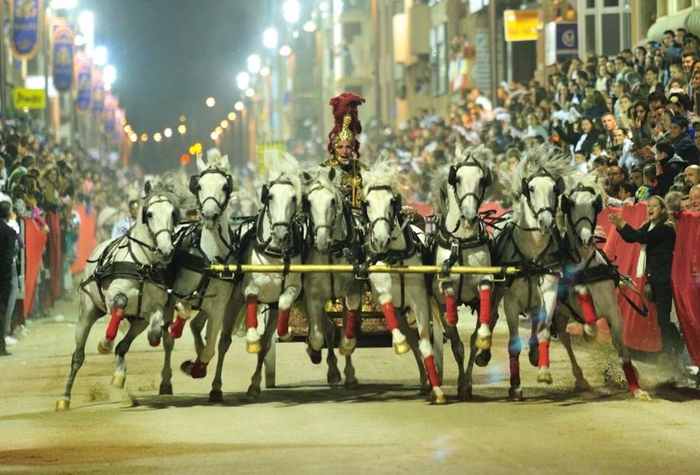 And the joy of this week is that every town is unique, every tradition unique, and each way of celebrating Semana Santa unique, which means that no matter how long you´ve been here, you´ve never truly "done " Semana Santa in Murcia.
And the joy of this week is that every town is unique, every tradition unique, and each way of celebrating Semana Santa unique, which means that no matter how long you´ve been here, you´ve never truly "done " Semana Santa in Murcia.
A few reports written after following the various days of Semana Santa:
Viernes de Dolores Cartagena, Sábado de Pasión Murcia, Domingo de Ramos Lorca, Click 3 cities, 3 Semana santas
Friday, Evening Lorca vía crucis and biblical procession, Click Lorca Friday evening
Palm Sunday, Domingo de Ramos, morning, Totana, Click Totana Domingo de Ramos
Palm Sunday, Domingo de Ramos, Cartagena evening, Click Cartagena Domingo de Ramos
Holy Monday, Lunes Santo, Murcia, Barrio of San Antolín, Click Lunes Santo Murcia
Holy Tuesday, Martes Santo in Alhama de Murcia, Click Martes santo
Holy Wednesday, Murcia, The Coloraos, Click Coloraos Murcia
Maundy Thursday, Lorca, Jueves santo, Click Lorca Jueves Santo
Friday, Morning, Procession of the Salzillos in Murcia, Click Salzillos Murcia
Good Friday, Lorca the Biblical procession, Click Lorca biblical procession
Saturday evening, Sábado de Pasión, La Unión, Click Sábado de Pasión
Resurrection Sunday, Cartagena, Click Resurrection day, Cartagena
Cartagena
El Carmoli
Islas Menores and Mar de Cristal
La Manga Club
La Manga del Mar Menor
La Puebla
La Torre Golf Resort
La Union
Los Alcazares
Los Belones
Los Nietos
Los Urrutias
Mar Menor Golf Resort
Pilar de la Horadada
Playa Honda / Playa Paraiso
Portman
Roldan and Lo Ferro
San Javier
San Pedro del Pinatar
Santa Rosalia Lake and Life resort
Terrazas de la Torre Golf Resort
Torre Pacheco
Aledo
Alhama de Murcia
Bolnuevo
Camposol
Condado de Alhama
Fuente Alamo
Hacienda del Alamo Golf Resort
Lorca
Mazarron
Puerto de Mazarron
Puerto Lumbreras
Sierra Espuna
Totana
Abaran
Alcantarilla
Archena
Blanca
Corvera
El Valle Golf Resort
Hacienda Riquelme Golf Resort
Lorqui
Molina de Segura
Mosa Trajectum
Murcia City
Peraleja Golf Resort
Ricote
Sucina
Condado de Alhama
El Valle Golf Resort
Hacienda del Alamo Golf Resort
Hacienda Riquelme Golf Resort
Islas Menores and Mar de Cristal
La Manga Club
La Torre Golf Resort
Mar Menor Golf Resort
Mazarron Country Club
Mosa Trajectum
Peraleja Golf Resort
Santa Rosalia Lake and Life resort
Terrazas de la Torre Golf Resort
La Zenia
Lomas de Cabo Roig
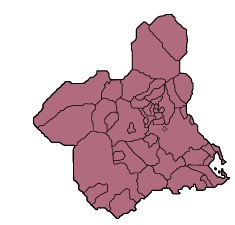
CAMPOSOL TODAY Whats OnCartagena SpainCoronavirusCorvera Airport MurciaMurcia Gota Fria 2019Murcia property news generic threadWeekly Bulletin
